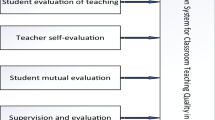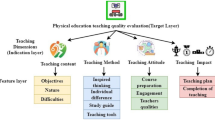Abstract
Improving the quality of education through effective teaching evaluation is crucial. A scientific and rational assessment system for physical education is important. The assessment of teaching is a complex and dynamic process, but utilizing the cutting-edge technology of fuzzy neural networks can help navigate this complexity. This study aimed to improve the assessment of physical education classes. The first step towards creating a multi-index evaluation system for college physical education instructors’ performance is to use the analytical hierarchy technique. This technique evaluates the instructor’s teaching content, method, attitude, and influence. In this study, a system was developed for physical education using a fuzzy neural network model to evaluate faculty members in college-level physical education workshops. The input for the fuzzy neural network model is the assessment evaluation, and its output is a vector that indicates the quality of the college physical education received by the student, classified as great, good, average, or bad. Compared to other approaches for evaluating the quality of physical education courses in higher education, the fuzzy neural network model has shown higher accuracy, specificity, sensitivity, and F1 score. After implementing the proposed methods for imparting physical education, there was a significant improvement in accuracy (95%), specificity (94%), sensitivity (92%), and F1 score (93%). The proposed method is more efficient than the traditional approaches.









Similar content being viewed by others
Data availability
Datasets analyzed during the current study are not publicly available, but may be requested from the corresponding author.
References
Ali M, Yin B, Kumar A, Sheikh AM et al. (2020). Reduction of multiplications in convolutional neural networks. In 2020 39th Chinese control conference (CCC) .pp. 7406–7411). IEEE. DOI: https://doi.org/10.23919/CCC50068.2020.9188843.
Aslam XD, Hou J, Li Q, Ullah R, Ni Z, Liu Y (2020) Reliable control design for composite-driven scheme based on delay networked T-S fuzzy system. Int J Robust Nonlinear Control 30(4):1622–1642
Bai Y (2022) An analysis model of college English classroom patterns using LSTM neural networks. Wirel Commun Mob Comput 2022:1–10
Bertolini R, Finch SJ, Nehm RH (2022) Quantifying variability in predictions of student performance: examining the impact of bootstrap resampling in data pipelines. Comput Educ Artif Intell 3:100067. https://doi.org/10.1016/j.caeai.2022.100067
Cao C, Xie Y, Zhou Y, Gong Y, Gao M (2020) Assessment of WeChat work online teaching modes under COVID-19: based on AHP and fuzzy comprehensive evaluation method. Open J Soc Sci 8(7):349–358
Chen Z (2019) Observer-based dissipative output feedback control for network T-S fuzzy systems under time delays with mismatch premise. Nonlinear Dyn 95:2923–2941
Chen Y, Zhai L (2023) A comparative study on student performance prediction using machine learning. Educ Inf Technol 28(9):12039–12057. https://doi.org/10.1007/s10639-023-11672-1
Fang C (2021) Intelligent online English teaching system based on SVM algorithm and complex network. J Intell Fuzzy Syst 40(2):2709–2719. https://doi.org/10.3233/JIFS-201693
Flores MA, Derrington ML (2018) Improving teacher evaluation: key issues for appraisers in a globalised era. Teach Teach 24(3):203–208. https://doi.org/10.1080/13540602.2018.1427017
Han Q (2022) Using neural network for the evaluation of physical education teaching in colleges and universities. Soft Comput 26(20):10699–10705. https://doi.org/10.1007/s00500-022-07267-w
Hazrat B, Yin B, Kumar A, Ali M, Zhang J, Yao J (2023) Jerk-bounded trajectory planning for rotary flexible joint manipulator: an experimental approach. Soft Comput 27(7):4029–4039. https://doi.org/10.1007/s00500-023-07923-5
Hon Keung K, Yaling C (1994) A fuzzy neural network and its application to pattern recognition. IEEE Trans Fuzzy Syst 2(3):185–193. https://doi.org/10.1109/91.298447
Huynh-Cam T-T, Chen L-S, Huynh K-V (2022) Learning performance of international students and students with disabilities: early prediction and feature selection through educational data mining. Big Data Cogn Comput 6(3):94. https://doi.org/10.3390/bdcc6030094
Kumar A, Shaikh AM, Li Y et al (2021) Pruning filters with L1-norm and capped L1-norm for CNN compression. Appl Intell 51:1152–1160. https://doi.org/10.1007/s10489-020-01894-y
Li N (2021) A fuzzy evaluation model of college English teaching quality based on analytic hierarchy process. Int J Emerg Technol Learn (iJET) 16(2):17–30
Liu W (2022) A study on the integration of business english teaching and intercultural communication skills cultivation model based on intelligent algorithm. Secur Commun Netw 2022:1–12
Liu K, Chen Z, Wu J, Wang L (2018) "FCNS: a fuzzy routing-forwarding algorithm exploiting comprehensive node similarity in opportunistic social networks. Symmetry 10(8):338
Liu C, Feng Y, Wang Y (2022) An innovative evaluation method for undergraduate education: an approach based on BP neural network and stress testing. Stud High Educ 47(1):212–228. https://doi.org/10.1080/03075079.2021.1946629
Ma L (2021) Research on the construction of university physical education innovation system based on cloud computing. In: Proceedings of the 4th international conference on information systems and computer aided education (ICISCAE), Dalian, China, September 24–26, pp. 60–64. https://doi.org/10.1145/3482632.348
Mañas-Álvarez F-J, Guinaldo M, Dormido R, Dormido S (2023) Robotic park: multi-agent platform for teaching control and robotics. IEEE Access 11:34899–34911. https://doi.org/10.1109/ACCESS.2023.3264508
Merino-Campos C, del Castillo H, Medina-Merodio J-A (2023) Factors affecting the acceptance of video games as a tool to improve students’ academic performance in physical education. IEEE Trans Educ Inform Technol 28(5):5717–5737. https://doi.org/10.1007/s10639-022-11295-y
Muhammad IQ, Majid A, Shamrooz S (2023) Adaptive event-triggered robust H∞ control for Takagi-Sugeno fuzzy networked Markov jump systems with time-varying delay. Asian J Control 25(1):213–228
Prasetyawan P, Ahmad I, Borman RI, Pahlevi YA, Kurniawan DE others (2018) Classification of the period undergraduate study using back-propagation neural network. In 2018 International conference on applied engineering (ICAE), pp. 1–5, IEEE, 2018.
Roy B, Gupta R (2020) MoDTRAP: improved heart rate tracking and preprocessing of motion-corrupted photoplethysmographic data for personalized healthcare. Biomed Signal Process Control. https://doi.org/10.1016/j.bspc.2019.101676
Sakamoto K, Morita K, Ikeda T, Kayamori K (2019) Deep-learning-based identification of odontogenic keratocysts in hematoxylin- and eosin-stained jaw cyst specimens. CoRR, vol. abs/1901.03857. [Online]. Available: http://arxiv.org/abs/1901.03857.
Shamrooz M, Li Q, Hou J (2021) Fault detection for asynchronous T-S fuzzy networked Markov jump systems with new event-triggered scheme. IET Control Theory Appl 15(11):1461–1473
Song H, Montenegro-Marin CE, Krishnamoorthy S (2021) Secure prediction and assessment of sports injuries using deep learning based convolutional neural network. J Ambient Intell Humaniz Comput 12:3399–3410. https://doi.org/10.1007/s12652-021-03191-6
Ullah R, Dai X, Sheng A (2020) Event-triggered scheme for fault detection and isolation of non-linear system with time-varying delay. IET Control Theory Appl 14(16):2429–2438
Wang L, Zhai Q,Yin B, et al (2019) Second-order convolutional network for crowd counting. Proc SPIE 11198, Fourth International Workshop on Pattern Recognition, 111980T. https://doi.org/10.1117/12.2540362.
Wei Y, Zhang H, Yin H (2020) Development of communication and sport in China based on mapping of knowledge information visualization. SAGE Open 10(1):2158244019900175
Xu H, Sun Z, Cao Y et al (2023) A data-driven approach for intrusion and anomaly detection using automated machine learning for the internet of things. Soft Comput. https://doi.org/10.1007/s00500-023-09037-4
Xuan Z et al (2022) DRN-LSTM: a deep residual network based on long short-term memory network for students behavior recognition in education. J Appl Sci Eng 26(2):245–252
Yang S, Jing Y, and Chen L (2022) Sports health analysis and promotion countermeasures of weak constitution college students based on K-means clustering: take a university in Beijing as an Example. In: Proceedings of the 4th world symposium on software engineering (WSSE), Xiamen, China, September 28–30, pp. 138–143. DOI: https://doi.org/10.1145/3568364.3568385.
Yao W, Guo Y, Wu Y, Guo J (2017) July. Experimental validation of fuzzy PID control of flexible joint system in presence of uncertainties. In 2017 36th Chinese control conference (CCC) (pp. 4192–4197). IEEE. DOI: https://doi.org/10.23919/ChiCC.2017.8028015.
Ye J, Huang B, Chen X (2021) An improved algorithm to enhance the performance of FAST TCP congestion control for personalized healthcare systems. Wireless Commun Mobile Comput 2021:9947883. https://doi.org/10.1155/2021/9947883
Yin B, Khan J, Wang L, Zhang J, Kumar A (2019). Real-time lane detection and tracking for advanced driver assistance systems. In 2019 Chinese control conference (CCC) (pp. 6772–6777). IEEE. DOI: https://doi.org/10.23919/ChiCC.2019.8866334.
Yin B, Aslam MS et al (2023) A practical study of active disturbance rejection control for rotary flexible joint robot manipulator. Soft Comput 27:4987–5001. https://doi.org/10.1007/s00500-023-08026-x
Zhang L, Dai H (2023) Motion trajectory tracking of athletes with improved depth information-based KCF tracking method. Multim Tools Appl 82(17):26481–26493. https://doi.org/10.1007/s11042-023-14929-6
Zhen C, Hu K (2022) Design of edge computing online classroom based on college english teaching. Comput Intell Neurosci 2022:1–11
Funding
This study was funded by the Exploration of the Path of Optimizing the Balanced Development of Physical Education Teaching Resources (Project no: HX202306).
Author information
Authors and Affiliations
Corresponding author
Ethics declarations
Conflict of interest
Authors declares that he has no conflict of interest.
Research involving human and animal rights
This article does not contain any studies with human participants performed by any of the authors.
Informed consent
Informed consent was obtained from all individual participants included in the study.
Additional information
Publisher's Note
Springer Nature remains neutral with regard to jurisdictional claims in published maps and institutional affiliations.
Rights and permissions
Springer Nature or its licensor (e.g. a society or other partner) holds exclusive rights to this article under a publishing agreement with the author(s) or other rightsholder(s); author self-archiving of the accepted manuscript version of this article is solely governed by the terms of such publishing agreement and applicable law.
About this article
Cite this article
Chen, R., Wang, T. & Kim, S. Optimizing teaching management in college physical education: a fuzzy neural network approach. Soft Comput 27, 19299–19315 (2023). https://doi.org/10.1007/s00500-023-09318-y
Accepted:
Published:
Issue Date:
DOI: https://doi.org/10.1007/s00500-023-09318-y




